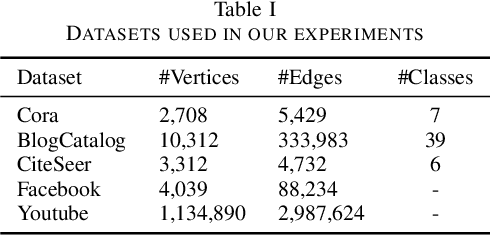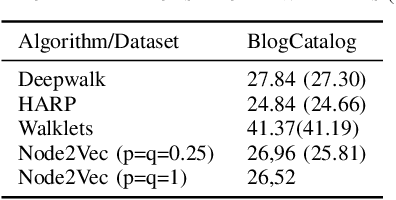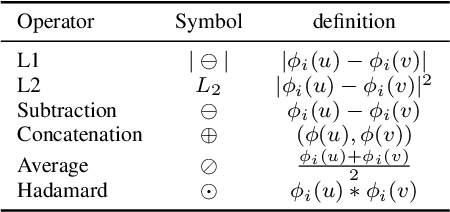Fatemeh Salehi Rizi
Investigating Extensions to Random Walk Based Graph Embedding
Feb 17, 2020



Abstract:Graph embedding has recently gained momentum in the research community, in particular after the introduction of random walk and neural network based approaches. However, most of the embedding approaches focus on representing the local neighborhood of nodes and fail to capture the global graph structure, i.e. to retain the relations to distant nodes. To counter that problem, we propose a novel extension to random walk based graph embedding, which removes a percentage of least frequent nodes from the walks at different levels. By this removal, we simulate farther distant nodes to reside in the close neighborhood of a node and hence explicitly represent their connection. Besides the common evaluation tasks for graph embeddings, such as node classification and link prediction, we evaluate and compare our approach against related methods on shortest path approximation. The results indicate, that extensions to random walk based methods (including our own) improve the predictive performance only slightly - if at all.
Global and Local Feature Learning for Ego-Network Analysis
Feb 16, 2020



Abstract:In an ego-network, an individual (ego) organizes its friends (alters) in different groups (social circles). This social network can be efficiently analyzed after learning representations of the ego and its alters in a low-dimensional, real vector space. These representations are then easily exploited via statistical models for tasks such as social circle detection and prediction. Recent advances in language modeling via deep learning have inspired new methods for learning network representations. These methods can capture the global structure of networks. In this paper, we evolve these techniques to also encode the local structure of neighborhoods. Therefore, our local representations capture network features that are hidden in the global representation of large networks. We show that the task of social circle prediction benefits from a combination of global and local features generated by our technique.
Predicting event attendance exploring social influence
Feb 16, 2020



Abstract:The problem of predicting people's participation in real-world events has received considerable attention as it offers valuable insights for human behavior analysis and event-related advertisement. Today social networks (e.g. Twitter) widely reflect large popular events where people discuss their interest with friends. Event participants usually stimulate friends to join the event which propagates a social influence in the network. In this paper, we propose to model the social influence of friends on event attendance. We consider non-geotagged posts besides structures of social groups to infer users' attendance. To leverage the information on network topology we apply some of recent graph embedding techniques such as node2vec, HARP and Poincar`e. We describe the approach followed to design the feature space and feed it to a neural network. The performance evaluation is conducted using two large music festivals datasets, namely the VFestival and Creamfields. The experimental results show that our classifier outperforms the state-of-the-art baseline with 89% accuracy observed for the VFestival dataset.
Shortest path distance approximation using deep learning techniques
Feb 12, 2020



Abstract:Computing shortest path distances between nodes lies at the heart of many graph algorithms and applications. Traditional exact methods such as breadth-first-search (BFS) do not scale up to contemporary, rapidly evolving today's massive networks. Therefore, it is required to find approximation methods to enable scalable graph processing with a significant speedup. In this paper, we utilize vector embeddings learnt by deep learning techniques to approximate the shortest paths distances in large graphs. We show that a feedforward neural network fed with embeddings can approximate distances with relatively low distortion error. The suggested method is evaluated on the Facebook, BlogCatalog, Youtube and Flickr social networks.
 Add to Chrome
Add to Chrome Add to Firefox
Add to Firefox Add to Edge
Add to Edge